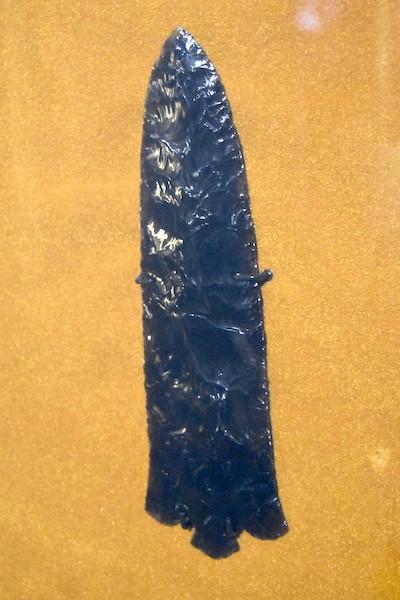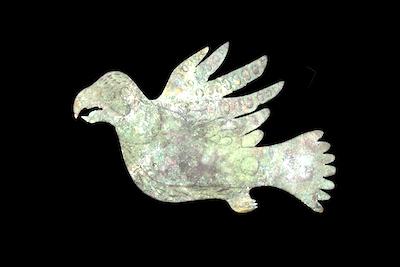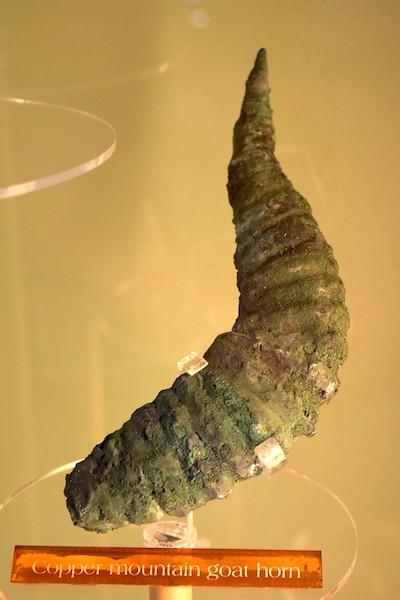
Hopewell Cultural National Historical Park is slowly giving up clues to its significance/NPS, Tom Engberg
Hopewell Culture: A Sacred Landscape
By Kim Kobersmith
The first mound I see at Hopewell Culture National Historical Park is in a little green space off the parking lot. It is not large, about 6 feet tall, and its perfect shape indicates it was sculpted by human hands. It is cared for, mown around, and kept clear of trees, but what is curious to me is that it lies on the opposite side of the parking lot from the main Mound City enclosure.
As I talk with the park’s superintendent and archaeologist, study expertly crafted artifacts, and visit several carefully engineered earthwork sites, that first curiosity is just one of many I encounter. There are many more questions than answers about the who, how, and why of this park in Chillicothe, Ohio. But thanks to technological breakthroughs and a renewed awareness of traditional knowledge, during the last 20 years archaeologists have uncovered fascinating aspects of this collection of earthworks and their sacred history.
Hopewell Culture Superintendent Chris Alford and park archaeologist Dr. Bret Ruby are passionate about the Hopewell Culture and that enthusiasm is contagious. They spent a couple of hours with me, animating the landscape and people who gathered here 2,000 years ago. As they explained the startling history and scientific feat of these earthen constructions, my imagination reached back in time to conjure a deep appreciation for the ancient people and sophisticated culture that formed this place.
There is no evidence that people lived in these earthworks, which were named after the family that once owned the land. They are believed to be part of a vast network of ceremonial sites, in use from 50 to 400 AD. They were the temples of a complex religion, practiced by people throughout the entire Eastern United States, and on high holy days would have been cosmopolitan cities full of elaborately dressed practitioners who spoke a panoply of languages.

Ceremonial obsidian spearpoint from Mound City Group. The stone is from Yellowstone National Park/Kim Kobersmith
This now quiet spot in southcentral Ohio was the cultural epicenter of this movement. In its heyday, it held a concentration of 500 sacred places that drew people to elaborate celebrations of both life and death. The national historical park preserves six different locations, four of which are open regularly to the public, that hold some of the largest known Hopewell monumental earthworks.
All the mounds and earthworks in the park were threatened before preservation by the National Park Service. They were eroded from farming, razed for a World War I-era military training camp, and excavated by amateur archaeologists. As a result, their outer appearance is not as impressive as their historical significance. Fortunately, they retain much rich archaeological evidence, hidden below ground level.
Hopewell City Group
Hopewell City Group is the natural place to begin a visit, as it hosts the park visitor center and museum. It is also the only site fully reconstructed to its original state.
Here, a low earthen wall surrounds 25 mounds of varying sizes. It is compact and easily walkable compared to other Hopewell sites. On my early morning visit, I find myself walking slowly, reverently. The space itself seems imbued with a sense of awe.
To the Hopewell people, this was a very sacred site. More than 100 people were cremated and interred here. For those burials, a ceremonial pit was dug and then a wooden structure was built above it. The body was laid to rest and accompanied by finely crafted artifacts. After cremation, the timber frame was torn down. Mounds were constructed over one, or multiple, burial pits.
Museum and Artifacts
The small museum inside the visitor center holds a collection of artifacts excavated from Mound City, many crafted from exotic materials. These materials were not part of regular trade routes but were intentionally collected for or brought to this sacred place from long distances, then expertly crafted for ceremonial use. Many of the materials were shiny and reflective and would have taken on an animacy in the firelight.
One of those materials was obsidian, used for spearpoints up to 17 inches long. More than 300 pounds of obsidian artifacts have been unearthed in Ross County, Ohio. That is more than 75 percent of all the obsidian found in the entire Eastern United States. Another common Hopewell material is copper, crafted into effigies and pieces for adornment.
Dr. Ruby explained that recent improvements in chemical analysis have revealed the sources of these materials. The obsidian comes from Obsidian Cliff in Yellowstone National Park, located 2,000 miles away in Wyoming. The copper was long believed to be from around Lake Superior, including copper mines at Isle Royale National Park. While the majority is from there, park staff was surprised to learn that a quarter of it came from the Southern Appalachians.
While the museum has some stunning examples of copper effigies and ceremonial obsidian spear points, the collection is only a glimmer of what the park mounds originally held. Previously excavated artifacts are part of the collections of the British Museum (from the 1840s) and the Ohio History Connection (in the 1920s). Discoveries from the largest known Hopewell mound, excavated in the 1890s, became the basis of Chicago's renowned Field Museum.

Copper Effigy excavated from Mound City Group in the 1920s. Much of the copper at Hopewell Culture is from the Lake Superior area, including copper mines found at today's Isle Royale National Park/NPS, Tom Engberg
Hopeton Earthworks
Alford and Dr. Ruby showed me two of the other park locations. (I was particularly grateful for their interpretation of the obscured earthworks – picturing them requires some creative imagination.)
Hopeton Earthworks is located just across the river from Mound City. Visitors can envision their original footprint thanks to a practice dubbed interpretive mowing. On my spring visit, the Hopeton geometry was clearly visible thanks to the fresh grass on most of the site contrasted with the brown plant material on the former walls. Alford explained the contrast changes through the seasons, and that late summer is particularly stunning with native goldenrod blossoming across the earthwork footprint.
Hopeton had a very different function than Mound City. It holds no burials, but instead was a carefully engineered complex with perfect geometrical shapes and numerous celestial alignments. As evidenced by the map, the great circle covers 20 acres yet is perfectly round. Ruby explains this great circle and other standard formations are the same size across Hopewell earthworks miles apart. Many of these geometrical shapes also correspond to each other, like the large square that fits perfectly inside the large circles.
The construction, too, was full of intentionality. First, the topsoil was stripped down to a firmer clay foundation. Carefully selected soils, red and yellow, composed both the interior and exterior of the walls. The construction was very quick, indicating a lot of people were involved in the process.

What is remarkable about this copper horn is that mountain goats don’t live anywhere near south-central Ohio/Kim Kobersmith
Solar and lunar alignments at Hopewell sites, in full evidence here, were not really discussed by archaeologists until the 1980s, but add an important layer of understanding about their purpose. A pair of parallel walls originally led from the river to the Hopeton ceremonial site. They were a quarter-mile mile long, 12 feet high, and perfectly aligned with the winter solstice sunset. Gap openings in the walls of the square correspond to the lunar cycle. To identify this 18.6-year-cycle would have required generational observation and study. To honor it would have required a high level of coordination and communication.
Hopewell Mound Group
The last site I visited was Hopewell Mound Group. It is massive: almost a mile across, covering 100 football fields and containing 32 mounds. It is the largest single enclosure studied to date and considered the cultural epicenter of the Hopewell movement.
To be honest, it can be hard to conjure up this site’s magnificence today. Though cleared with interpretive signs and remnants of the two-mile perimeter earthen wall, the field is mostly flat and has a power line running across the center. This site, too, incorporates interpretive mowing, but since the Park Service mows the footprints of the walls and mounds, the contrast is not significant in early spring.
But as we look across the expanse, Dr. Ruby brings it to life. See that slight rise over there? That was the largest Hopewell mound known to exist, measuring 33 feet high, 180 feet wide, and 500 feet long. The organizers of the 1893 World’s Columbian Exposition in Chicago, wanting to showcase America’s past, sent several teams of archaeologists across the nation with Hopewell Mound Group as one of the stops.
“This Hopewell mound held the greatest number and diversity of artifacts with the finest craftsmanship of all the sites in the country,” said Dr. Ruby.
He then showed me a map of the site and indicated a massive circle, larger than a football field. Old maps indicate this circular embankment was already obliterated by 1890. Yet revolutionary technology incorporating high-level magnetometry is revealing an abundance of ritual Hopewell architecture at all of the sites.
With specific knowledge from the magnetometry, Dr. Ruby led recent archaeological work. He discovered the earthwork was lined with 2-foot diameter poles that were both inserted and removed in a ceremonial way. Four central pits, more than ten feet in diameter, would have been sufficient to feed 200 people apiece. A gateway in the circle marked the summer solstice sunset. The archaeologist imagines that hundreds of people created these sacred sites, then gathered to mark celestial moments with feasting and celebrating. It is a compelling vision.
Dr. Ruby explained, too, that the park is gaining new understandings through intentional connections with Native Americans.
“With the Indian Removal Act, native peoples were forcibly removed from Ohio and disconnected from their sacred places,” he said. “The why’s of our discoveries about the Hopewell Culture are more fruitfully answered in conversation with native peoples. To be gifted a story is an honor, and we have to show we deserve to know it.”
This year, the park celebrates 100 years of permanent protection for the Mound City Group as part of the National Park System. Even with that history, though, one of the biggest threats to Hopewell Culture sites has been apathy. But the national historical park and three related Ohio state sites are awaiting possible recognition this fall of UNESCO World Heritage Site status. The application process has launched a renewed appreciation for and interest in Hopewell stories, many of which are still harbored underground.
Kim Kobersmith writes about arts, culture, and the outdoors from Berea, Kentucky, a creative small town where the Appalachian Mountains meet the bluegrass. She enjoys tying on her hiking shoes and exploring nearby trails.


Add comment